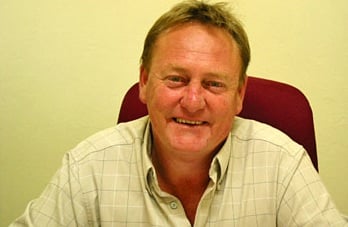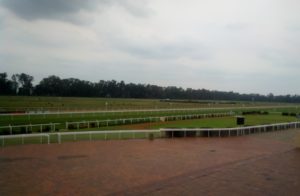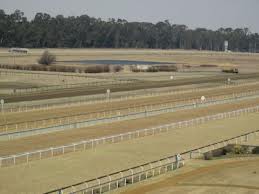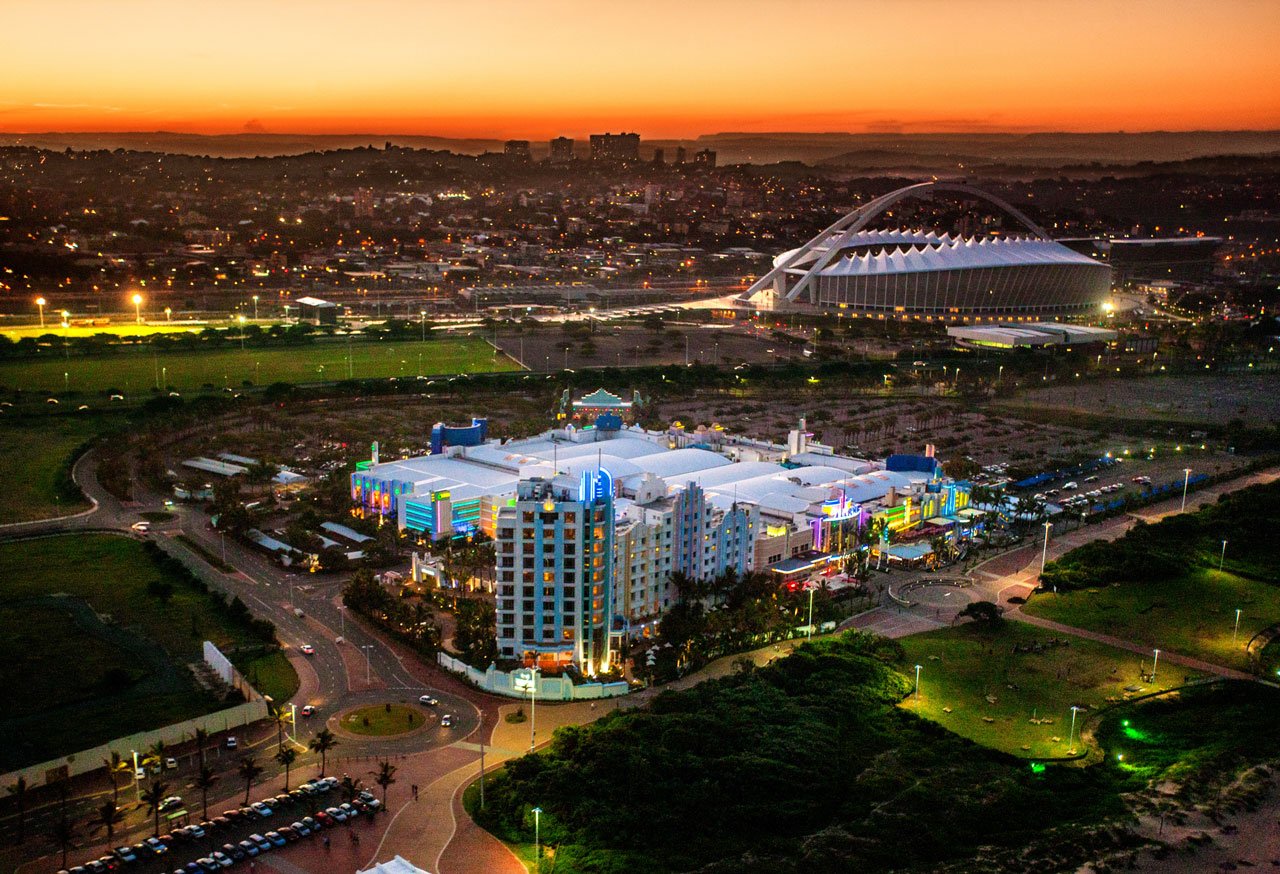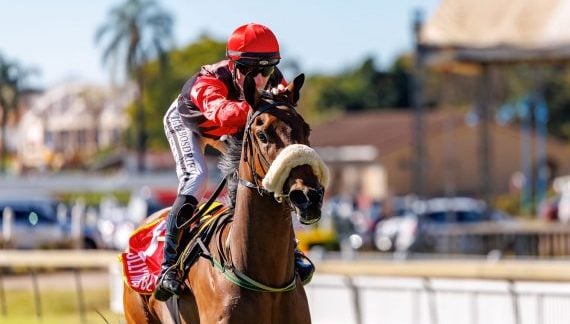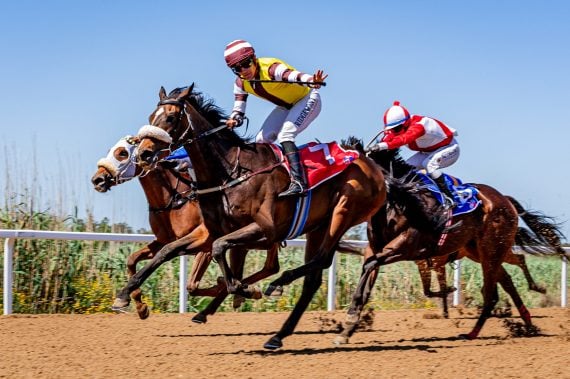Louis Goosen is the Chairman of the Vaal Trainers. He has forged a reputation for being a straight-talker and speaking his mind, even when he knows his opinions might be unpopular. We chat to him about that awful accident on the R59, his runners for today and ask his opinion about the Vaal sand track.
LGRS’s groom Mongezi Geledu was involved in that dreadful recent road accident on 5 June 2015 and Louis confirmed that Mongezi is still in hospital, and will require extensive rehab work, but is keeping his spirits up and doing well. “We’ve all been to visit. Mongezi suffered broken ribs, a broken femur, broken bones in his feet and hands and he also lost one of his little fingers. He’s an absolute top class guy. He never went to school and doesn’t speak much English, but he loves horses and we’ve all got huge respect for him back at the yard. He’d completed the first course with James Maree and was finishing the second one with a view to being able to race ride. It’s going to be a long road to recovery, but they’re looking after him and we’re behind him all the way.”
Vaal runners
Louis also has 5 runners for the Vaal sand on Thursday, 17 June – including stable star Trip Tease – so while we had him on the line, we thought we’d ask about his runners.
“My first runner is Blue Tractor in race 3. He ran in a 1000m last week and it was definitely too short for him. I suspect he wants a mile or even 1800m, but the 1450m should suit and I expect him to go close. In race 4, Dontbeamoegoe has been scratched. She’s A Tiger – race 6 – has been sold to stud, so it’s her last run for us. You can ignore her last start – she slipped in loose sand at the start. I expect her to go close.”
“In race 7 we’ve got Miss K. I advised her owner Keith Steinberg to have a bet on her last time out, but it got cancelled because the jockeys wouldn’t ride in the sand going. She’s very well and I expect her to be a huge runner on Thursday.”
“My big runner on the day is Trip Tease. He’s sound and he’s well and we’re expecting him to win. The plan is to take him softly through winter and then send him to Harold Crawford to prep for the Cape Flying Championship. Harold is part of the team and always does a great job caretaking our horses. We’ll send Trip Tease down early, so that he can have a bit of a break, visit the beach, enjoy himself and get ready. That’s our plan for the summer season and we are not prepared to take unnecessary risks. People have been working tirelessly on the Vaal track, but if there are any question marks over the going, we will scratch. I’ll make a call on the day.”
Vaal sand
It sounds as though the issue of the Vaal sand has not been resolved. Louis is the Chairman of the Vaal trainers association, so we asked for his opinion.
Louis explains, “The Vaal sand surface used to be washed sand, but it had broken down and was forming false bases at different levels. Horses were slipping out of the pens and while galloping and numerous horses were put to sleep due to injuries they sustained on the track. Injuries were primarily to the near fore due to concussion and to the off hind due to slippage. To compensate, the horses ended up running Indian file. Everyone agreed that it wasn’t horse friendly and it wasn’t punter friendly either.”
“When we changed, we all opted for unwashed sand as we felt it would be more horse friendly. I’ll explain how it works. The surface is composed of larger grained sand, mixed with finer clay particles. The bigger grains are the working medium, and then you’ve got the finer clay particles as the binding material. The third component is water, which acts as the catalyst to bind the clays to the sand to make your running surface.”
“By and large, the new surface was very horse friendly for 3 or 4 years. It was probably a little heavier than the previous track, but it worked fine and very few horses were being injured. However, there was a period of about 2 – 2.5 years where it was not maintained as well as it could have been. You must understand that the track gets used to train as well as race on. Because of that, in my opinion, the track was not kept in racing mode on a consistent, daily basis. Instead of being prepared and maintained 7 days a week, it was prepared on a Tuesday and Wednesday for racing on Thursday. On Friday, Saturday, Sunday and Monday it was left with basic, minimal watering and the track conditioner going over it.”
“The problem with that is that when the sand dries out, the smaller, heavier clay particles sift downwards and when the wind comes up, it blows away all the loose sand at the top. Over time, the levels drop and you’re left with an imbalance of the fine to the larger grained material. The whole structure destabilises and becomes difficult to manage. Coupled with this, the new tractors are far too heavy, they don’t have treadless tyres and they’re actually loosening the sand, which is making the problem even worse.”
“For the last year to year and a half we’ve seen a rapid deterioration. I think it’s been neglected for longer than that, but the results have become more noticeable. I don’t think it’s correct to blame the horsemen who originally requested the new sand or even the sand track itself, it’s simply a lack of correct, consistent maintenance. Now that the damage has been done, they are constantly rolling and trying to compact it, but there’s only so much you can do when your raw materials are fundamentally incorrect.”
“The result is that the track stays heavy, because the sand is not binding the way it should. In fact it can’t, because the balance is incorrect. They keep trying to compact it, but they’re not getting the levels they should. Even after the compactor has been over it, there are holes and tractor tracks. The surface is uneven and they don’t seem able to even it up. Horses are pecking on the going and not enjoying the surface. The bigger, stronger horses are managing to cope, but smaller horses can’t act in the deep going. If you look back at the 9th of June, I sent out Wishful Heart in a MR80 handicap. River Trip had the form to beat us, but just went up and down in the heavy going. It’s unfair to punters.”
But some horses simply act better (or worse) on certain going. “Yes, of course, you get your mudlarks and your horses that prefer firmer going, some like it heavy, some fast etc, but the problem that the public faces is that a sand course is always declared as ‘standard’ going. The heavy going is causing form reversals and these are completely new form lines that are being established. The point is that the public has to spend their money in order to find this out.”
Management
“The current course manager, Mr Ndlovu, is a top class guy and someone I greatly admire. He started out at Newmarket and was the guy in charge of the guys repairing the divots. He worked his way up. He eventually ran Clairwood and then he came here. He’s a top class course manager and probably one of the best turf managers I’ve seen. All things considered, he does an unbelievably great job. He is probably the most helpful course manager we’ve ever had, he understands training tracks and you cannot fault him in terms of keeping things neat and tidy, but by his own admission he has not been trained or raised on sand.”
Wasn’t the track manager trained in how to look after the sand track when it was installed? “I’d prefer not to comment. Our senior track manager is Stan Diesel (no relation to Vin Diesel) and he’s been around since before the sand was put in. He’s out there daily trying to fix the track – you tell me why he’d be out there if there was no problem? Look, he’s got my complete sympathies as I feel he’s trying to do mission impossible – the man’s name is not Harry Potter. It’s tough for him and he’s trying to fix something that’s not fixable because the levels are quite simply incorrect and no amount of rolling is going to fix that.”
What about a synthetic solution? “I am not against a poly track, just afraid of what will happen if the maintenance isn’t carried out properly. A polytrack reacts to humidity and moisture. Centres like PE, Durban and Cape Town have natural moisture – it’s not the same here – and the Randjes poly isn’t spoken of highly by trainers. The maintenance of a polytrack is even higher than sand and my concern is that we would end up with the same scenario. It’s all a question of maintenance.”
“Sand racing is necessary in winter in Gauteng due to the rock hard turf surfaces. Properly maintained, sand is a horse friendly surface, but right now they are constantly rolling in a futile attempt to get the desired compaction, which cannot happen without the proper balance of components. However, I believe that the Vaal sand CAN be repaired and then it will result in good, horse friendly racing again.”
So what would you do to fix it? “I’m not a geologist, but I have had some experience building my own track. As an immediate measure I’d say a 100ml top up is needed. We could use local sand and then rotivate it into the existing sand. We are standing on the banks of the Vaal. In fact, there is beautiful sand right behind grandstand. We have sand coming out of our ears! Why can’t we use that? Next I would suggest narrowing the course by 6 or 7m. No-one uses the entire breadth of the sand track and it creates extra maintenance and expense that’s not necessary. I pointed out back as 2001 already that we could cut the bend around the dam and make a 650m run in. That would probably reduce the maintenance by a third.”
“The old Vaal turf track was also very wide with a strip of unfavourable going up the middle which caused the fields used to split into two groups – one on either side of the track, to avoid the bad middle going. The current configuration has a rail down the middle of the track, creating two narrow courses with a draw bias. However, the fields are still running on those original two strips – the inside of the inside course and the outside of the outside course – and it causes interference and false racing. My suggestion would be to cut the shorter straight and narrow the sand course, then widen the turf and we will have better racing and less pressure on track staff because there will be a lot less maintenance.”
All sand is not equal
What about Kimberley then? That’s also sand. Why is that so different? “Look, it’s not as good as it was under the late Peter Miller – nobody could beat him – but it’s still streets ahead of the current Vaal surface. The current Kimberley track manager has made a couple of mistakes, and in my opinion the track had a lot more kickback on Monday than it had a year ago when I was last there, but I can tell you now that the jockeys say there’s no comparison. A horse that’s scratchy here at the Vaal, floats at Kimberley. That course is redder and is made of the local sand. It’s light, about an inch, maybe inch and a half deep and it has very little kick-back. Phumelela looked at getting some for the Vaal, but the transport costs make it unfeasible.”
Is the kickback a real issue, or are the jockeys just complaining about the comfort factor? “Sure, it’s uncomfortable being hit in the face with the Vaal sand and it is more severe because the Vaal kickback is higher because the sand is looser, but it’s more an issue of judgement. The kickback makes visibility difficult, so if you get caught behind the front runners, it’s nearly impossible to see when to go and when not to go. It impairs their judgement and it’s hard for them to read a race. And what about the horses’ well being? The horses’ nostrils are flared when they’re running and they’ve got sand going into their nose and lungs – they don’t enjoy it either. And when they get kickback into their face, it makes them hesitate, and even a fraction of a second can cost you a length or two and you can’t make it up in that going.”
But where does that leave people in the meantime? “I went to walk the course this morning and it looks great, but we’ll have to see how it holds up once it’s had a field of horses over it. The course can only be rolled once inbetween races, so we’ll have to see. I had 5 runners at Kimberley on Monday, you’ll have to read between the lines.”


